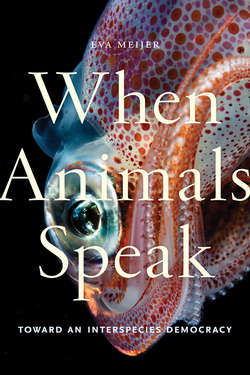Читать книгу When Animals Speak - Eva Meijer - Страница 12
На сайте Литреса книга снята с продажи.
Political Animal Voices: A Brief Summary
ОглавлениеIn this book, I develop a theory of political animal voices. I do so in three steps. The first part of the book focuses on language. It offers a critique of viewing language as exclusively human, as well as an alternative to that view. In chapter 1, “The Animal, What a Word! Human Language and Non-Human Animals,” I investigate the relation between language and anthropocentrism. By examing the connections between human language and non-human animal exclusion, I argue that, in order to adequately address anthropocentrism, we need to redefine language in and through interaction with non-human animals. Chapter 2, “Animal Languages,” turns the focus to non-human animal languages. In this chapter, I draw on empirical studies of animal languages and cultures to provide a better insight into their worlds as a starting point for conceptualizing interspecies interactions and world-building. I draw on Wittgenstein’s later work, and specifically on his concept “language games,” to develop an alternative way of conceptualizing and studying animal languages and interspecies languages, and I discuss different non-human animal and interspecies language games. In chapter 3, “From Animal Languages to Interspecies Worlds,” I investigate how we can conceptualize language between animals of different species, and I explore the role that language plays in constructing common worlds with other animals. The first case study, “Stray Philosophy: Dog-Human Observations on Language, Freedom, and Politics,” builds on these insights. In this case study, I draw on my personal experiences with Romanian stray dog Olli to explore philosophical concepts around three themes: language, freedom, and politics. By emphasizing Olli’s perspective and actions, I also aim to explore ways to move beyond anthropocentrism in philosophy. This case study concludes the first part of the book about animal languages and interspecies worlds, and opens the door to the second.
The second part of this book focuses on interspecies politics; it challenges an anthropocentric demarcation of the political, and develops an alternative, which takes into account non-human animal agency and interspecies political relations. In chapter 4, “Animal Politics: Justice, Power, and Political Animal Agency,” I criticize an anthropocentric view of politics from the perspectives of justice and power relations. I investigate political non-human animal agency and discuss how non-human animal agency can function as a basis for developing new forms of interspecies politics. In chapter 5, “Animals and the State: Citizenship, Sovereignty, and Reformulating Politics,” I further explore the relation between groups of non-human animals and human political communities through a discussion of recent proposals for citizenship and sovereignty for non-human animals, and critiques from the perspective of republicanism. I also discuss examples of new ways of relating to other animals, as found in existing institutions, which can function as beginnings for further reformulating laws and political practices such as labor rights, habitat rights, and urban planning. Chapter 6, “Worm Politics,” moves the discussion to political relations between humans and earthworms to investigate the relevance of species membership for interaction, and to further clarify the borders of the political and political action. The second case study, “Goose Politics: Resistance, Deliberation, and the Politics of Space,” focuses on goose-human relations in the Netherlands. I investigate the goose-human conflict around Schiphol Airport and, based on the insights developed in the second part of this book, I argue that goose agency needs to be taken into account for normative and practical reasons. I also shed light on how goose agency can be translated to existing political practices and institutions.
The third and final part of the book draws on the insights into language and politics developed in the first two parts to investigate how existing political practices and institutions can be extended to incorporate non-human animal political voices, and to explore new ways of interacting with other animals politically. Chapter 7, “Animal Activism and Interspecies Change,” focuses on the role of non-human animals as agents of social and political change. Acknowledging this agency is important in order not to reinforce silencing mechanisms, and can open up new ways of thinking about social and political change, as well as contributing to imagining and creating new interspecies communities. In chapter 8, “Animal Democracy and the Challenges of Political Participation,” I discuss why political participation is important for different groups of non-human animals, and how we can further improve political non-human animal participation. In the final chapter, “Deliberating Animals: From Multispecies Dialogues to Interspecies Deliberation,” I develop an interspecies understanding of deliberation in order to bridge the distance between existing dialogues between human and non-human animals and human political systems. In the conclusion, “Thinking with Animals,” I discuss thinking and writing with other animals. I also offer recommendations for further research.
